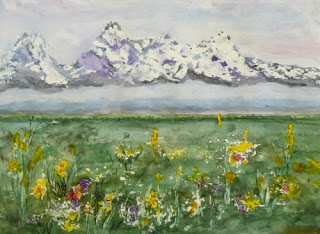First we considered color intensity. Colors become less intense as objects recede. We mixed complements to gradually decrease color intensity and found a variety of grayed colors to use. Too often painters rely on one neutral to create gray tones.
 Second, we created a simple scene using these grayed colors, beginning with a wet-in-wet background. In the distance value contrast decreases and there are fewer details and softer edges.
Second, we created a simple scene using these grayed colors, beginning with a wet-in-wet background. In the distance value contrast decreases and there are fewer details and softer edges.
Ruskin painted the background hills wet in wet to create lost edges. He was able to balance these shapes with small detail in the foreground.
 Sue set a figure in the distance by creating detail and stronger values in the foreground.
Sue set a figure in the distance by creating detail and stronger values in the foreground. Rita let her trees disappear gradually into the distance. The detail and stronger hues in front bring the foreground forward.
Rita let her trees disappear gradually into the distance. The detail and stronger hues in front bring the foreground forward. Carol used wet in wet technique to create soft edges in the background shapes and more intense color in the foreground.
Carol used wet in wet technique to create soft edges in the background shapes and more intense color in the foreground.



